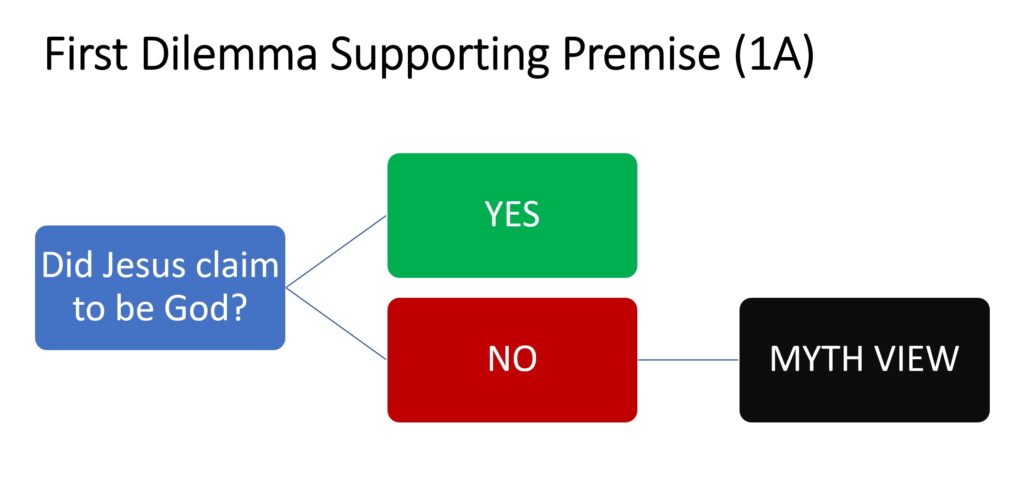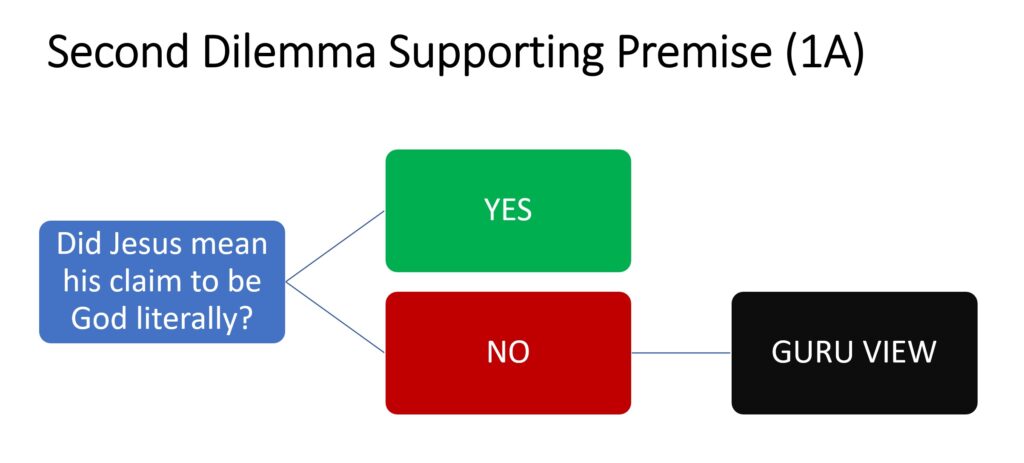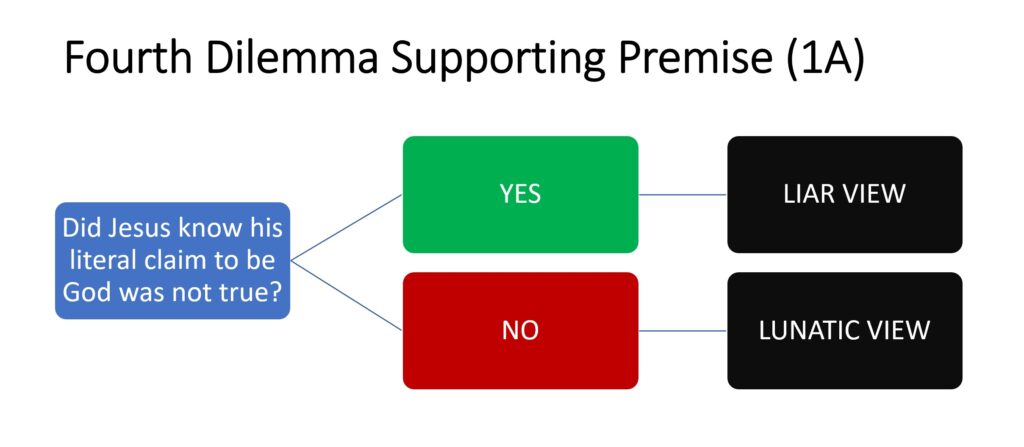Kreeft’s Case for the Divinity of Jesus – Part 11: Evaluation of Premise (1A)
WHERE WE ARE
In Chapter 7 of their book Handbook of Christian Apologetics (hereafter: HCA), Christian philosophers Peter Kreeft and Ronald Tacelli make a case for the divinity of Jesus. Here is the main argument they present in Chapter 7:
1A. Jesus was either God, liar, lunatic, guru, or myth.
2A. Jesus could not possibly be a liar, lunatic, guru, or myth.
THEREFORE:
3A. Jesus is God.
In Part 3 of this series, I analyzed and clarified a series of four dilemmas (four EITHER/OR statements) that they use to support premise (1A). The four dilemmas are used to try to prove that there are only FIVE possible views that can be taken on this issue.
In Part 4 of this series through Part 9 of this series, I have shown that the FIRST DILEMMA contains an INVALID inference, and I have shown that the SECOND DILEMMA contains an INVALID inference. I agreed with Kreeft and Tacelli that the inference in the THIRD DILEMMA is logically VALID.
In Part 10 of this series, I have shown that in the FOURTH DILEMMA there is one VALID inference (to the LIAR VIEW) and one INVALID inference (to the LUNATIC VIEW). Therefore, there are INVALID inferences in three out of the FOUR DILEMMAS, and just one INVALID inference is enough to sink Kreeft and Tacelli’s FOUR DILEMMAS argument in support of premise (1A) of their case for the divinity of Jesus. So, they have utterly and completely FAILED to show that this key premise of their argument is true, and that premise remains DUBIOUS, at best.
CRITICAL EVALUATION OF PREMISE (1A)
My conclusion at the end of Part 10 is that premise (1A) remains DUBIOUS, at best, because Kreeft and Tacelli have utterly and completely FAILED to provide a sound argument for this premise. But a stronger conclusion than that is warranted by my objections showing that there are at least three INVALID inferences in their argument supporting premise (1A). My objections against those three inferences also show that premise (1A) is in fact FALSE. So, now I will briefly review those objections and explain how they show that premise (1A) is FALSE.
THE OBJECTION TO THE INFERENCE IN THE FIRST DILEMMA

In order to evaluate the inference in the FIRST DILEMMA, I had to clarify the meaning of the “MYTH VIEW”.
The MYTH VIEW is true IF AND ONLY IF:
(a) at least ONE New Testament writing asserts or implies that Jesus claimed to be God,
AND
(b) it is NOT the case that Jesus claimed to be God.
Obviously, if the answer to the first basic question (i.e. “Did Jesus claim to be God?) is NO, then condition (b) would be satisfied. The only thing remaining that would need to be determined is whether condition (a) was also satisfied.
It appears that it might well be the case that (a) is FALSE, that NO NT writing asserts or implies that Jesus claimed to be God, and therefore even if we have good reason to conclude that it is NOT the case that Jesus claimed to be God, the MYTH THEORY might well be wrong, and thus the logic of Kreeft and Tacelli’s first dilemma would be mistaken. If the answer to the basic question “Did Jesus claim to be God?” is NO, it still might be the case that the MYTH THEORY was FALSE, because it might well be the case that no NT writing asserts or implies that Jesus claimed to be God.
The VIEW that Kreeft and Tacelli FAILED to take into account is the VIEW that the following two claims are true:
- Jesus never claimed to be God.
- The New Testament nowhere asserts or implies that Jesus claimed to be God.
This is MY view, and since I am a skeptic, I will call this the SKEPTIC VIEW. The SKEPTIC VIEW differs from the MYTH VIEW, because according to the MYTH VIEW there is one or more passages in the New Testament that assert or imply that Jesus claimed to be God. The SKEPTIC VIEW also differs from the other four VIEWS (the GURU VIEW, the LORD VIEW, the LIAR VIEW, and the LUNATIC VIEW). Therefore, the SKEPTIC VIEW constitutes a COUNTEREXAMPLE to premise (1A), and proves that premise (1A) is FALSE. There are clearly more than just the five VIEWS outlined by Kreeft and Tacelli in premise (1A).
THE OBJECTION TO THE INFERENCE IN THE SECOND DILEMMA

Whether or not the Gospel of John presents an accurate view of the historical Jesus, it presents a logically possible version of Jesus in which the inference that Kreeft and Tacelli make in the SECOND DILEMMA would be mistaken, and thus the logic of that dilemma is INVALID. In short, the Jesus presented in the Gospel of John provides a CLEAR COUNTEREXAMPLE to the inference made in the SECOND DILEMMA presented by Kreeft and Tacelli.
I argued that the characterization of Jesus found in the Gospel of John has two relevant aspects:
- Jesus never means his claim to be God literally.
- Jesus believes that some humans are divine or “from God” while other humans are evil or “from the devil”.
The VIEW of Jesus presented in the Gospel of John is thus contrary to the GURU VIEW, because according to the GURU VIEW Jesus believed that ALL human beings are divine or “from God”.
The VIEW of Jesus as satisfying the above two bulleted statements is one in which Jesus views humans as taking opposing sides in a great battle between good and evil. This is a theological view that was reflected in the STAR WARS movies, so I will call this the STAR WARS VIEW of Jesus. The STAR WARS VIEW is clearly different from the GURU VIEW, and it is also clearly different from the other four VIEWS (the MYTH VIEW, the LORD VIEW, the LIAR VIEW, and the LUNATIC VIEW) specified by Kreeft and Tacelli. It also differs from the sixth VIEW that I just introduced above: the SKEPTIC VIEW.
Therefore, the STAR WARS VIEW constitutes another COUNTEREXAMPLE to premise (1A), and proves that premise (1A) is FALSE. There are clearly more than just the five VIEWS outlined by Kreeft and Tacelli in premise (1A).
THE OBJECTION TO AN INFERENCE IN THE FOURTH DILEMMA

There are two inferences in the FOURTH DILEMMA. My objection was that the inference from a NO answer to the question posed in the FOURTH DILEMMA to the LUNATIC VIEW is an INVALID inference.
Kreeft and Tacelli are mistaken when they infer the LUNATIC VIEW from a NO answer to the question “Did Jesus know his literal claim to be God was not true?” It is possible for a person, including Jesus, to be a rational adult of normal cognitive ability who is NOT GOD, to nevertheless NOT KNOW that he was NOT GOD. Therefore, this inference in the FOURTH DILEMMA is logically INVALID.
I argue that it was possible that Jesus could have entertained a bizarre theological idea or theory (such as the TWO MINDS theory) that would have prevented him from accepting the evidence of his own experience as indicating that he was NOT omnipotent, NOT omniscient, NOT eternal, and NOT perfectly good. The acceptance of such a bizarre theological idea or theory would not, however, imply that Jesus was LITERALLY INSANE (that he had a very serious mental illness).
Because the acceptance of bizarre theological ideas is fairly common and not viewed as implying INSANITY or LUNACY, we can call this VIEW of Jesus, the THEOLOGICALLY CONFUSED VIEW. If Jesus accepted a strange or bizarre theological belief that prevented him from recognizing that he was an ordinary, finite, limited, and imperfect human being, but that did not otherwise impact his ability to cope with reality, to survive, and to get along with other people, then he would still have been a rational adult with normal cognitive ability who, nevertheless, did NOT KNOW that he was NOT GOD, even though this fact might have been fairly obvious apart from his bizarre theological theory.
The THEOLOGICALLY CONFUSED VIEW is clearly different from the LUNATIC VIEW, and it is also different than the MYTH VIEW, the GURU VIEW, the LORD VIEW, and the LIAR VIEW. So, the THEOLOGICALLY CONFUSED VIEW is a clear COUNTEREXAMPLE to premise (1A), and it shows that premise (1A) is FALSE.
The THEOLOGICALLY CONFUSED VIEW is also different from the other views that I introduced above: the SKEPTIC VIEW and the STAR WARS VIEW.
CONCLUSIONS ABOUT PREMISE (1A)
In previous posts in this series, I argued that three of the series of FOUR DILEMMAS presented by Kreeft and Tacelli contained INVALID inferences. Since only one INVALID inference would be sufficient to sink this argument for premise (1A), it is clear that they have utterly and completely FAILED to show that premise (1A) is true.
In this post, I argued that my objections not only show that there are three INVALID inferences in the argument presented by Kreeft and Tacelli in support of premise (1A), but that there are three clear COUNTEREXAMPLES to premise (1A), each of which shows that premise (1A) is FALSE. There are at least three more VIEWS that Kreeft and Tacelli failed to take into account: the SKEPTIC VIEW, the STAR WARS VIEW, and the THEOLOGICAL CONFUSION VIEW.
Therefore, not only is the argument given by Kreeft and Tacelli for premise (1A) clearly a BAD argument, but premise (1A) is clearly FALSE. So, their argument for the divinity of Jesus is based on a premise that is FALSE, and that argument is thus UNSOUND and should be rejected.
NOTE: There is also yet another obvious VIEW that Kreft and Tacelli failed to take into account: the NO JESUS VIEW (the view that Jesus was not an actual historical person).



